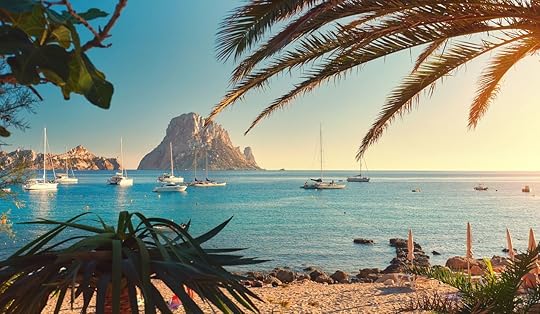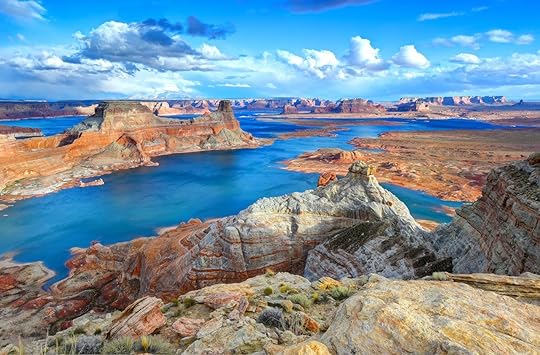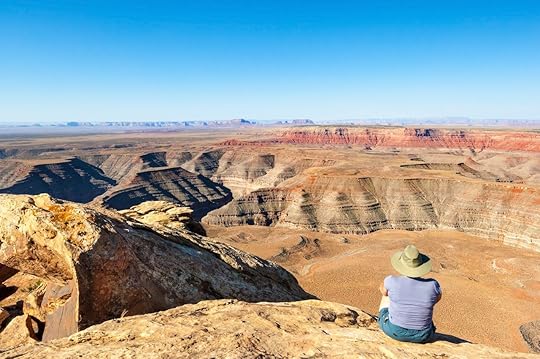Matador Network's Blog, page 1044
July 31, 2019
Cable car between Russia and China

Forget planes, trains, and automobiles — the best way of getting from Russia to China is soon going to be a cable car ride.
The gondola is planned to run between Heihe in northeast China and Blagoveshchensk in Russia, above the Amur River, and will be the world’s first cross-border cable car. Each car will be able to convey up to 60 passengers at once for quick three-and-a-half-minute ride, reported CNN.
The Blagoveshchensk angular cable car terminal, designed by Dutch architecture design studio UNStudio, will be built over several levels with terraces and green plateaus. The plan is for the terminal to be more than just a place for travelers to pass through — it will act as a viewing platform, urban park, as well as a space for events and performances.

Photo: UNStudio/Facebook

Photo: UNStudio
The project is still in its planning stages, but construction on the cable car and terminals is expected to begin in 2020. 

More like this: 7 awesome cable car rides around the world
The post The world’s first cross-border cable car will take you between Russia and China appeared first on Matador Network.

Arctic wildfires set record

The Arctic, the land of ice and polar bears, is burning. Since the start of June, the Copernicus Atmosphere Monitoring Service (CAMS) has tracked over 100 “intense and long-lived” wildfires in the Arctic Circle.
Indeed, global warming has caused Arctic temperatures to rise at a much quicker rate than the global average, creating conditions conducive to wildfires. They were even so massive that they could be seen from space, with giant plumes of smoke rising from parts of Siberia, Greenland, Alaska, and Canada. According to the World Meteorological Organization (WMO), this past June was Earth’s warmest June on record.
Thomas Smith, environmental geographer at the London School of Economics, said that these fires are bad news for an already struggling climate. “The fires are burning through long-term carbon stores,” he said, “emitting greenhouse gases, which will further exacerbate greenhouse warming, leading to more fires.”
Luckily, much of the Arctic area affected by wildfires is sparsely populated, but wind can carry wildfire pollution thousands of miles. The Siberian fires, for example, extended 1.7 million square miles across central and northern Asia. In Russia the situation appears even worse, with 11 out of 48 Russian regions currently experiencing wildfires, and there are 2.06 million acres engulfed in Alaska.
Unfortunately, according to the WMO’s Claudia Volosciuk, the fires are only precipitating a series of climate events that make global warming even worse. “When particles of smoke land on snow and ice,” she said, “[they] cause the ice to absorb sunlight that it would otherwise reflect, and thereby accelerate the warming in the Arctic.”
And as you can imagine, extinguishing fires in the Arctic is rather difficult. The best hope right now is heavy rainfall. 

More like this: 12 experiences you can only have in Arctic Europe
The post The Arctic is having the worst season for wildfires on record appeared first on Matador Network.

Missile launcher found in bag

If you combed through the TSA’s confiscated items, you’d probably find some pretty surprising stuff, but few are more baffling than a missile launcher.
On Monday morning, officers at Baltimore/Washington International Thurgood Marshall Airport found a missile launcher in a man’s checked bag, and of course, it was immediately taken away.
The passenger, from Jacksonville, Texas, told officials that he was an active-duty military officer traveling home from Kuwait, and wanted to keep the missile launcher as a souvenir.
Lucky for him, the passenger did not face any consequences apart from the launcher’s confiscation, and was allowed to catch his flight. The TSA did, however, use the incident as a reminder to the public that there are specific rules about the transportation of firearms and ammunitions and that they should be checked prior to heading to the airport. It wrote in a tweet, “Perhaps he should have picked up a keychain instead!”
.@TSA officers at @BWI_Airport detected this missile launcher in a checked bag early this morning. Man said he was bringing it back from Kuwait as a souvenir. Perhaps he should have picked up a keychain instead! pic.twitter.com/AQ4VBPtViG
— TSAmedia_LisaF (@TSAmedia_LisaF) 29 juillet 2019
According to TSA Public Affairs spokesperson Lisa Farbstein, it’s pretty common for TSA officers to find firearms in travelers’ luggage. At Pittsburgh International Airport alone, 23 guns were stopped at the airport this year. 

More like this: 10 things you can and can’t take through the US border
The post Missile launcher found in passenger’s checked bag appeared first on Matador Network.

Ibiza’s best wellness and health

With a sound similar to an Ujjayi breath, the low humming of cicadas sets the pulse for sun salutations. On a deck overlooking a vista of pine forests, there is a palpable sense of calm. A small orange gecko climbs a wall nearby, wriggling its way into a canopy of fuchsia bougainvillea. A short walk away is a beach with water so crystal clear you can see schools of fish swimming near the bottom. This is a less seen side of Ibiza, a place where not only can you hear yourself think, but you can tap into that inner voice.
With a party-hard reputation, Ibiza is not the first place you might think to go for a little R&R. Known by most as a land of all-night raves, the White Isle’s wellness community is rapidly growing, perhaps as a reaction to the debauchery. It makes sense why. The lush natural setting is perfect for yoga shalas, sustainable farm-to-table restaurants, and agritourism.
Where to stay on a wellness trip to Ibiza

Photo: Pawel Kazmierczak/Shutterstock
Head to northern Ibiza for peaceful hotels and less crowded beaches. While the island is small, renting a car is a must to get from place to place, as some of the most scenic points are in remote locations. The area near Portinatx and Santa Eulalia are ideal for settling in. Whatever you do, avoid staying near Dalt Vila, as it’s swamped with party-going tourists.
For the budget traveler, numerous Airbnbs offer ample space and a homey feel. You can easily find a quiet place to stay in the northern hills with extra features like yoga, fresh meals, and accommodations ranging from spacious rooms to huts, teepees, and more. Five minutes from Benirrás Beach is Ibiza Yoga, a popular Airbnb and yoga retreat.
Agritourism is a growing movement in Ibiza, and there is a smattering of beautifully converted farmhouses across the island in which to stay. Staying at a working organic farm will give you a true taste of local cuisine and culture. The family run Atzaro is a well-known example with a spa if you’re looking to spend a bit more for a luxurious experience.
Discover quiet beaches less trodden

Photo: lunamarina/Shutterstock
Sheltered Cala Benirrás is not a hidden beach per se, but there’s no denying its beauty and tranquility. The enclosed bay creates a little oasis that feels private. There’s no music being played as you often find at other beaches on the island, save for a drumming party on Sunday nights. Two restaurants skirt the beach along with a little market of local clothing and goods, from dresses to jewelry and more. Benirrás has one of the best views on the island for the sunset, so be sure to stay until 9:00 PM.
Near Portinatx is the beautiful bay of Cala Xarraca, a favorite of photographers. This is an ideal beach to go snorkeling and has the unique feature of natural mud baths on the left side of the bay. Don’t be afraid to get dirty, the mud has natural healing properties for the skin.
Instead of sleeping in all day because you’ve been out all night, rise with the sun and go for a long hike to the “secret” Moon Beach. Bring plenty of water as there are no shops or restaurants anywhere to fill up. Even the most intrepid hikers will want to do the walk in the morning when it is cooler. You’ll know when you’re getting close to the beach by the strange “moon rocks” that have been bleached white by the sun. The small beach is incredibly scenic and private. There might be a few naturists or you might be lucky enough to be alone in the enchanting cove.
Wellness beaches and attractions on Ibiza

Photo: Alex Tihonovs/Shutterstock
In addition to spots perfect for lazy beach days, Ibiza has art, music, and quite a few spots worth exploring. One is Es Vedrà, a lone rock standing proudly in the sea. Legend has it that it’s the third most magnetic spot in the world, and though there’s no evidence to support that legend, there certainly seems to be some kind of spiritual force surrounding the area. Then again, other legends claim it’s the tip of Atlantis or a base for UFO landings. Whether or not there is magnetism, healing energy, or something even more elusive surrounding Es Vedrà, it’s worth a visit to ponder for yourself.
Channel your existential thoughts at “Time and Space,” a public art installation by Andrew Rogers on the cliffs of Cala Llentia. Nicknamed the “Stonehenge of Ibiza,” the monument is comprised of 13 giant basalt pillars. The center monolith is covered in 23-karat gold and designed to represent the sun at the center of our galaxy. To see it at its best, head to the installation just before sunset and savor the glow of the island.
When partygoers get bored of partying in Ibiza, they head to Formentera, and it’s easy to see why. A day trip to the smallest of the Pityusic Islands can be organized by catching a ferry from the mainland. The vibe is quiet and peaceful, and there more grown-up cocktail bars than raves. Rent motorbikes to travel between the sun-drenched beaches as they are all beautiful.
To end the week with a bang, a visit to Benirrás Beach on Sunday nights is a must to hear the drummers who come from all around to give the sunset a proper salute. It’s truly freeing to throw your hands in the air as you dance about something as simple as a sunset. Of course, this isn’t your average sunset. As the giant golden orb makes its descent into the pastel tinged waters, the drumming and excitement become more frantic. Escape the crowds with a refreshing swim in the clear waters — the bay will feel like your private bath.
Where to eat healthy meals in Ibiza

Photo: The Giri Ibiza/Facebook
If hot weather and time spent in a bathing suit aren’t strong enough motivators to seek out healthy fare, then the wide range of delicious, in Ibiza certainly will be. The artisan food scene is booming with farm-to-table options that are much better for your body than over-processed food.
Many of the best restaurants stand alone in rural settings, so again, you need that car. For a simple Mediterranean lunch and fresh juices, head to Aubergine near San Miguel or The Giri Café near Portinatx. Take your time at the beautiful rustic settings in the countryside as you savor the slower pace of the north side of the island. There’s nothing better than seasonal, local, and sustainably sourced produce. Enjoy organic vegetables and a glass of rosé while soaking up the ambiance.
The sleepy village of Santa Gertrudis is where you’ll find a concentration of delicious farm-to-table restaurants. Vegan fare awaits at Wild Beets, where you can indulge in Instagram-worthy raw dishes. For a more traditional (yet still organic and wholesome) lunch, head to La Paloma, which puts a Middle Eastern twist on Mediterranean cuisine that’s nothing short of divine.
Best wellness retreats and festivals on Ibiza

Photo: Yogarosa Retreats/Facebook
If you’re longing for full immersion and transformative experiences, there are many yoga and meditation retreats scattered across the island. To choose, start by deciding which yoga style you would like and the level of difficulty. Some yoga retreats have classes all day, whereas others have other options like paddleboarding and meditation. Yogarosa is one of the most popular traditional yoga retreats on the island. There are also teacher training classes for those looking to get more serious. If you fancy spending most of your time at sea, there are even yoga boat retreats.
Every April and October, Ibiza’s wellness community comes together for a one-day festival of wholesome goodness. Balance your chakras with the array of activities at the Ibiza Spirit Festival, where you’ll find things like solar sacred dance, tantra, sound meditation, tarot card readings, and more. A festival is a good taste of what the island has to offer, but you should dig into the wellness scene for a week or more if possible. 

More like this: Forget Bali and Tulum. These are the next big beach destinations for wellness.
The post Secret Ibiza: How to find peace on a party island appeared first on Matador Network.

Erawan Shrine in Bangkok

Long musical chimes resonate among the chaotic taxi honks and revving motorcycles. A thick layer of smoke from hundreds of burning incense sticks envelops the corner of Ratchadamri Road and Phloen Chit Road in the district of Pathum Wan in Bangkok. Hidden behind the smoke sits a cross-legged golden statue inside a glittering, mosaic pavilion surrounded by stacks of bright marigold leis. Locals call it the four-faced Buddha (Phra Phrom) or Brahma, and it may just be the most famous religious legacy in Thailand.
Who is the four-faced Buddha and what’s it doing at a busy intersection?

Photo: drpnncpptak/Shutterstock
It was only a few decades ago that the Thai people created their own version of the Hindu god of creation, Brahma, at the Erawan Shrine. The initial idea was to ward off the curses and spirits that plagued the grounds of the Erawan Hotel next door. After a series of injuries to the workers and a sunken shipment of the hotel’s expensive marble stones, the shrine was erected, giving the rest of the hotel’s days a smooth sailing. Today, the Erawan Hotel no longer exists and has been replaced by the Grand Hyatt Erawan Hotel.
Locals and tourists now frequent the shrine for good luck and blessings as it’s known to grant whatever is wished. The shrine receives so much traffic that workers remove the offered flowers and incense sticks every few minutes.
Around the world, including cities like Vancouver, Taipei, and Hong Kong, replica shrines have been built by devotees to honor this divine guardian.
Symbols displayed and rituals performed

Photo: kan Sangtong/Shutterstock
Like the original Hindu Brahma, the Buddha at Erawan Shrine has four faces. Facing the shrine’s entrance, the front face represents career and life. Continuing clockwise, the second is symbolic of relationship and family, the third is for wealth, and the last for wisdom and health. Locals believe that walking around the figure anti-clockwise is only recommended for those who partake in illegal businesses.
The Buddha has eight arms and hands, all of which carry significant meaning:
The book represents knowledge.
The string of beads symbolizes the control of karma.
The spear represents willpower.
The flower vase is symbolic of sacred water, where all requests are fulfilled.
The conch shell is the offering of wealth.
The flying wheel represents the clearing of disasters, gloominess, and evil.
The cinta mani, an inscribed relic, represents the almighty power of the Buddha.
The position of the hand over the chest means compassion.
Hills of chained fresh marigold blooms, crown flowers, and jasmine buds dangle around the pavilion. Called phuang malai, chained flowers are offered for their bright yellow color, which symbolizes good luck and the everlasting mother nature. Visitors can buy garlands, incense, and worshipping items like wooden elephants, dancing figurines, and fresh, drinkable coconuts at a small booth at the back of the shrine. For $1.50, worshippers get a set that comes with four small phuang malai, four candles to drive away darkness, and a small pack of incense.
Along the left wall of the shrine, a fleet of large wooden elephants are decorated with squared gold flakes, which visitors can buy and stick onto the carvings for good luck. Devotees know to aim for the trunk for a showering of good fortune. Gold flakes cost $2 for five pieces.

Photo: kikk/Shutterstock
At the stage at the rear of the shrine, a group of dancers in silk costumes adorned with gold and silver sequins and tiered headdresses await their turns. Do not mistake their four-minute routines as performances for tourists — they dance for the Buddha. Devotees whose wishes are granted will hire the dancers to perform to thank the deity. Their counterparts, dancing figurines, are also placed on the Buddha’s offering tables after a granted wish. Dancing performances cost anywhere from $15 to $80 and can be arranged at a registration desk beside the stage.
Brahma is said to be born from a lotus, so devotees at the Erawan Shrine will ask for a lotus flower from staff at the pavilion. They dip the tip of the bloom in sacred water stored in a basin at the left corner of the shrine and sprinkle it onto themselves to get rid of bad luck. Visitors are welcomed to use the water to wash away bad luck, even without a lotus flower.
For those looking to carry the power of the deity with them everywhere they go, staff at the pavilion sell a small amulet where the Buddha is encased in glass for $8. Large ones cost from $16 to $25.
To pray, head to the front of the Buddha and bow three times. Then place the incense and candle into the sandpit and the garland onto the fence around the pavilion. Make sure to walk clockwise to all four faces. You may make a wish, but if you do, remember to state how you plan to thank the Buddha when it comes true.
Rules and tips to know before visiting the Erawan Shrine

Photo: Phuong D. Nguyen/Shutterstock
Avoid talking loudly as many may be praying around you. For women, avoid wearing spaghetti straps, cover your thighs, and avoid praying when you are on your period as that is considered disrespectful in Thai culture. Make sure you buy offering items inside the shrine, since prices at the booths by the entrance are three to four times more expensive. 

More like this: The 7 most amazing temples in Thailand outside of Bangkok
The post The story behind the famous four-faced Buddha in one of Bangkok’s busiest intersections appeared first on Matador Network.

July 30, 2019
US-Mexico border wall seesaw

With all the political discourse surrounding the US-Mexico border, a whimsical giant seesaw might be the last thing you’d expect to find there. A new interactive art installation, however, has indeed been built at the border fence that separates Sunland Park, New Mexico, and Ciudad Juarez in Mexico. The project was designed by Ronald Rael, architecture professor at the University of California, Berkeley, and Virginia San Fratello, associate professor of design at San Jose State.
Rael said in an Instagram post, “The wall became a literal fulcrum for the US-Mexico relations, and adults were connected in meaningful ways on both sides with the recognition that the actions that take place on one side have a direct consequence on the other side.”
View this post on InstagramA post shared by Ronald Rael (@rrael) on Jul 28, 2019 at 11:22pm PDT
According to photos posted on Rael’s social media, the seesaw has already succeeded in bringing the two countries together, as both children and adults — from both countries — can be seen playing on the installation.
The idea for the project was first revealed in the book Border Wall as Architecture: a Manifesto for the US-Mexico Boundary. The book, edited by Rael, proposes that “the nearly 700 miles of wall is an opportunity for economic and social development along the border that encourages its conceptual and physical dismantling.”
On the actualisation of this long-envisioned project, Rael wrote, “[This is] one of the most incredible experiences of my and [San Fratello’s] career, bringing to life the conceptual drawings of the Teetertotter Wall from 2009 in an event filled with joy, excitement, and togetherness at the border wall.”
The installation comes on the heels of the announcement from the Supreme Court on July 27 that President Trump will be given $2.5 billion in Pentagon funds for a section of the wall on the southern border. 

More like this: The real differences between Cinco de Mayo in Mexico and the US
The post Seesaw installation on the US-Mexico border brings people from both sides together appeared first on Matador Network.

Chili to be grown in outer space

Outer space isn’t exactly the most hospitable environment for botany, despite what the movie The Martian would have us believe, but this lucky New Mexico chili plant, selected by NASA, gets to be launched to the International Space Station in March 2020. The chili, from Española, New Mexico, will be part of NASA’s research on how to produce food outside the Earth’s atmosphere. Jacob Torres, an Española native and NASA researcher, said that the point of sending the chili plant into space is to prove that NASA’s Advanced Plant Habitat works for fruiting crops, as well as leafy greens. It would be the first fruiting plant grown by the US aboard the Space Station.
“If we do go on a deep space mission,” Torres said, “or we do go to the moon or a mission to Mars, we will have to figure out a way to supplement our diets. Understanding how to grow plants to supplement the astronaut’s diet would be essential to our mission to going to Mars. So that kind of fuels our research that we’re doing now.”
The plant itself is a hybrid of the northern New Mexico seed and the Sandia seed and was chosen because of its shorter growth cycle and ability to thrive in small confines.
According to Matthew W Romeyn, NASA’s lead scientist on the project, “As a bonus, the Española Improved is one of the few chili pepper cultivars from the Hatch Valley that is also regularly consumed red, so we can leave it to the crew to decide if they would like their chili peppers green or to wait for the fruit to fully ripen to red.” 

More like this: How to eat healthy while traveling, according to three nutritionists
The post New Mexican chili to be the first fruiting plant grown in outer space appeared first on Matador Network.

The best types of hot dog in America

The hot dog is the most American of foods. Inspired by sausages from German immigrants, improved on by entrepreneurial newcomers to America’s shores, and beloved for more than a century by every social class, the hot dog represents Americana in ways no other food can. Yet as much as hot dogs unify every barbecue from coast to coast, they also divide, as the humble hot dog is among the most regional dishes in the country.
I eat my fair share of hot dogs and travel a lot. I’ve not, however, eaten every type of regional hot dog. There are dozens of different hot dog styles out there, and it’d take someone with much more stamina than I to seek them all out and clog their arteries in the name of hot dog journalism. My arteries are only half clogged. Also, our budget doesn’t allow us to go to Hawaii to try a Puka Dog, spectacular as they sound.
These are the 10 standout hot dog styles around the US — for better or worse — that I am able to weigh in on, ranked from technically edible to amazing drunk food to “I could eat this for every meal.”
10. Red snapper dog from Maine

Photo: Ray Bernoff/Shutterstock
You only have to look at a Maine red snapper once to decide whether you’re going to be the type of person who digs in, or the person who turns and runs. The name refers to both its color and texture. It’s red because it’s loaded with food coloring, and it’s a snapper because of the snap of the casing you get when you bite into one. Cartoon devil red is the only way to describe the shocking color of these dogs, which are for some reason loved by locals, but they often terrify unsuspecting tourists who innocently ordered a hot dog for their picky child off the kid’s menu.
Maine red snappers are mostly made by W.A. Bean & Sons, which uses a mixture of pork and beef stuffed in a natural lamb casing and dyed red. No one really knows why the color — that’s just the way it is and has been for generations. The upside? It doesn’t taste as unnatural as it looks, and the thick snappy casing could be texturally appealing to some (or extremely off-putting to many). It’s also served on a buttered and toasted top-split New England roll (the same one used for the state’s more famous lobster rolls), which is arguably one of the best hot dog vessels out there. But to find out all those upsides you have to get past the initial thought of eating something that unnatural looking, and even if you do give it a go, we eat with our eyes, and it’s a hard impression to shake.
Where to try it: Order from W.A. Bean & Sons.
9. Scrambled dog from Columbus, Georgia

Photo: Dinglewood Pharmacy/Facebook
My first journalism internship was at the lovely Columbus and the Valley magazine in Columbus, Georgia. While there, I tested out the scrambled dog, a style that loosely fits into the category of hot dog (more on that later). I loved my internship, and I loved the people of Columbus, but nothing can make me love a scrambled dog.
This style is pretty much only found in Columbus, Georgia, so bonus points for true regionality. But there’s a problem: The scrambled dog defeats the whole point of a hot dog because it’s near impossible to eat without a spoon.
A scrambled dog is made with a hot dog (sometimes cut into pieces), chili, and oyster crackers. Other possible toppings include onions, relish, coleslaw, and cheese. Whatever the toppings, the whole mess is dumped onto a toasted bun on a dish, where the chili-hot dog sludge covers the bread like a chunky biblical flood.
Dinglewood Pharmacy sells hundreds of these things a week. People there love them. So much so that it was put on the Georgia tourism board’s “100 Plates Locals Love” in 2016. While it has its select few charms, it’s more of a bready chili with a weenie in it.
Where to try it: Dinglewood Pharmacy, 2991, 1939 Wynnton Rd, Columbus, GA 31906
8. Seattle dog

Photo: Brent Hofacker/Shutterstock
There’s a good chance you’ve never heard of a Seattle dog unless you’ve been to the namesake city or select parts of the Pacific Northwest. Yet what the Seattle dog lacks in ubiquity and name recognition, it makes up for with one very memorable ingredient: cream cheese.
Yes, the Seattle dog is a hot dog with cream cheese. If you’re thinking this sounds like something made up by someone who couldn’t decide between a bagel and a hot dog, you’re right. Hanna Raskin wrote the oral history of the Seattle dog for Seattle Weekly and traced it back to a man named Hadley Longe, who in 1988 started a bagel cart in Pioneer Square. He was making vegetarian bagels, but everyone kept asking for hot dogs. So he took bialy sticks (elongated, hand-rolled, bagel-like bread), smeared cream cheese on it, and then threw a hot dog in it.
“I didn’t want to be a hot-dog guy,” Longe told Raskin. “I wanted to be the bagel man. So even though I sold hundreds of bagel dogs, I always waited for the person who would still want a veggie bagel.”
I, too, wish people had only wanted the veggie bagel. Longe’s creation took off in Seattle. Today, you’ll find Seattle dogs made with a frank or sausage that’s grilled and split in half, and placed on a toasted bun (the bialys are long gone) with cream cheese and your choice of onions, jalapenos, pico de gallo, barbeque sauce, whatever.
Where to try it: Monster Dogs food cart
7. Papaya dog from New York City

Photo: Papaya King/Facebook
New York City is where America’s hot dog dreams were born. Also where they came to die, depending on who you ask. For this ranking, I’m going to refer to the New York dogs that people here actually eat, not the dirty water dogs found floating like dead fish in the bowels of a street cart. The ideal New York hot dog is the Papaya dog, which is warmed on a griddle, squeezed between a basic roll that’s slightly too small, and topped with yellow mustard, sauerkraut, and red onion sauce. It’s simple, a balance of sour and savory, and one of the cheapest meals you’ll get in the city. Two of them to-go from Papaya King (or the similar Papaya Dog or Gray’s Papaya) at 4:00 AM will stave off any drunchies better than a piece of 99 cent pizza. It’s beautiful in its simplicity and is personally tied to many memories, but it lacks the innovation to rank higher on this list.
Where to try it: Papaya Dog, Papaya King, or Gray’s Papaya.
6. Coney Island dog from Detroit

Photo: Brent Hofacker/Shutterstock
Of the many hot dog styles around the US inspired by Brooklyn’s early Greek immigrants, Detroit’s Coney Island dog is the most famous. It’s a hot dog on a steamed bun that’s lathered in a beanless, meaty chili and topped with chopped white onions and mustard. It’s similar to the scrambled dog, but less soupy, and crucially has a bun, making it (somewhat) easier to eat with your hands.
The Coney Island dog is a category unto itself. It’s the origin of styles like Rhode Island’s hot weiner (also known as the Original New York System after the restaurant it was popularized at) and the Appalachian dog (more on that below). It also has little to do with what you’ll find at Coney Island in New York City.
The book Coney Detroit by Joe Grimm and Katherine Yung traces the Coney dog to Greek red sauce brought by immigrants in the early 1900s. Greeks would travel to the US and pass through New York City’s Coney Island, the beach where hot dogs are still zealously celebrated every year on July 4. They took the hot dog concept with them when they left the city. In Detroit, Coney Islands came to mean any Greek diner that serves Coney Island dogs but also salads, burgers, and other fare.
It’s a wonderful history filled with the stuff that makes America grand: immigration, the mashing of food styles, and regional pride in doing things differently. But the ground beef meat sauce is overkill. It’s like a sloppy Joe but on an elongated bun with a hot dog thrown in there. The whole thing an unbalanced mass of meat and carbs determined to sit like a rock in your stomach. Go ahead and dive right in if you’re not planning on eating for the rest of the day, though.
Where to try it: American Coney Island, 114 W Lafayette Blvd, Detroit, MI 48226
5. Appalachian dog

Photo: Hillbilly Hot Dogs/Facebook
Like the Coney Island dog, the Appalachian dog (also known as a West Virginia hot dog) is a hot dog on a steamed bun with beanless chili, chopped onions, and mustard. There’s one major difference: coleslaw. It’s popular in West Virginia and the Appalachian South and is superior to the northern iterations of the Coney Island dog.
Yes, it’s still a meat bomb. The creamy coleslaw adds some balance, though, both in texture and flavor. Contrasts make food interesting, and a slightly sweet, cabbage-based coleslaw is just the contrast needed to make a meat-on-meat hot dog crave worthy. It’s believed to have originated at a roadside drive-in near Charleston, West Virginia, in the late 1920s, according to Mountain Xpress. Hot dogs and cabbage were some of the most readily available and affordable foods at the time, so the two were combined. From there, it spread south to other states touched by the Appalachian Mountains.
Where to try it: Hillbilly Hot Dogs, 6951 Ohio River Rd, Lesage, WV 25537
4. The Polish Boy from Cleveland

Photo: Seti’s Polish Boys/Facebook
Of all the good bois in the hot dog universe, the Polish Boy is one of the most good. Its centerpiece is a grilled kielbasa (a Polish sausage made with beef, pork, or both). The kielbasa sits on a sturdy roll and is topped with coleslaw, French fries, and a healthy pour of barbecue sauce and hot sauce. It has the balance of the Appalachian dog without too much slop, and the tang of a Papaya dog with an extra kick. And while the carb-averse might balk at both a bun and fries all in one, those people shouldn’t bother with hot dogs in the first place. Fries are almost always better when added to the main dish instead of served on the side (though nothing beats fries added to the main dish and served on the side).
The Polish Boy is a Cleveland thing. Just like you wouldn’t visit Portland, Maine, without getting a lobster roll, don’t visit Cleveland without getting a Polish Boy.
Where to get it: Seti’s Polish Boys food truck, W. 42nd Lorain Ave. Cleveland, Ohio
3. Tijuana dog

Photo: Robson90/Shutterstock
Most popular in Los Angeles, but also found in smaller numbers in cities like San Francisco and San Diego, the Tijuana dog is yet another hot dog style that has little geographical relation to its name. But who cares. It’s absolutely delicious.
Also known as a “danger dog,” Tijuana dogs are hot dogs wrapped in bacon and either griddled or deep fried. The meat-wrapped meat is placed in a cheap hot dog bun and topped with grilled jalapeños, pico de gallo, crema, avocado, cilantro, radish, and cotija cheese. They taste best when purchased from a street vendor who may or may not have a license to sell food.
The Tijuana dog has its roots in Hermosillo, a city in the northern Mexico state of Sonora. The dogs were a hit around the Universidad de Sonora, because if anyone knows the true love found in a bite of deep fried street food, it’s college kids. The concept made its way north to Arizona and California where it morphed into something new, as food tends to do. In the latter, it can compete with the streetside taco in deliciousness if not in name recognition. The toppings somehow make what is essentially a fried meat stick taste fresh. The bite of the jalapeño is matched by the crumbly cotija cheese. Slices of radish are a refreshing palate cleanser. It is, simply, pure joy.
Where to try it: Preferably from a street vendor outside a bar
2. Sonoran dog from Arizona

Photo: Suzi Pratt/Shutterstock
In Arizona, the other state where Hermosillo’s bacon-wrapped hot dog found a home, it’s known as a Sonoran dog and is popular in cities like Phoenix and Tucson. Where the California version went light and fresh, Arizona went all in. The bacon dog is topped with a mound of beans, salsa, guacamole, jalapeños, and cheese. To keep it all together, it’s put in a bolillo, which is kind of like a stubby French bread roll that’s most commonly used for tortas.
The Sonoran dog edges the Tijuana dog for a couple reasons. First, it’s topped with a meal’s worth of ingredients without being bogged down. Second, the bolillo is simply a better vessel for salsa, cheese, and a greasy dog. Few meals satisfy on this level.
Where to try it: El Guero Canelo, multiple locations in Tucson and Phoenix
1. Chicago dog from Chicago

Photo: Cody Engel/Shutterstock
There’s no better form of tube of meat between a bun than the Chicago dog. It’s made with an all-beef, natural casing dog topped with peppers, mustard, relish, onion, tomato, celery salt, and a whole pickle spear. All of that is squeezed into a poppy seed bun. Each bite is a harmony of flavors and textures that play off each other in a way both heavenly and sinfully indulgent.
The combo was cooked up in the melting pot of Chicago in the 1920s and bolstered with vegetables (or “dragged through the garden”) during the lean Depression years. Today, hot dog stands serving up traditional Chicago dogs are a staple in the city and its surrounding suburbs.
To understand what makes it so good, you have to start with the pickle. The spear runs parallel to the dog in the bun like two inseparable best friends, adding extra crunch to each bite. The short peppers add more vinegar tang and a touch of heat while the tomato and onion keep it fresh. A soft poppy seed bun is essential. It doesn’t add a whole lot of flavor, but it’s hard to call it a Chicago dog without those little specks getting stuck in your teeth.
While it’s hard for me to get behind some of Chicago’s other food styles (what’s with the pizza?), the Windy City is undeniably the home of the best hot dog style in the US.
Where to try it: Byron’s, 1701 W. Lawrence Avenue Chicago, IL 60640 

More like this: Every American pizza style, ranked
The post The 10 most famous hot dog styles in America, ranked appeared first on Matador Network.

Things to do in Lake Powell

A friend of mine in the church once described Lake Powell to me as “Mormon Cabo.”
And, yes, a typical weekend on this 186-mile-long lake in the Glen Canyon National Recreation Area will find you sharing it with a large number of large families. They’re onto something, as it’s truly one of the more under-appreciated natural wonders of the American Southwest, home to 2,000 miles of shoreline and over 96 towering side canyons.
Lake Powell’s roots are controversial. It was formed in the 1960s when the construction of Glen Canyon Dam flooded the Colorado River and created the lake. The ground was sacred to Native Americans and the natural environment was never the same. But now that the lake exists, it offers unparalleled access to the red rock canyons along the Arizona–Utah border. Spending a few days here should be part of any visit to this part of the country.
Getting there
As most things in the middle of the desert tend to be, Lake Powell isn’t exactly easy to access. It’s about a four hour drive from Phoenix, the nearest major airport, and 7.5 hours from Las Vegas. The most direct way of reaching the lake is by flying into Page, Arizona, one of the smaller commercial airports you’ll find, which has a handful of daily nonstops to Phoenix Sky Harbor International Airport. Flights aren’t horrifically expensive either, about $100 each way.
Getting onto the water

Photo: Kenzos/Shutterstock
Once there, you’ll need a boat to venture onto the lake. You’ll find a couple of marinas near Page — Wahweap and Antelope Point — the former of which has boats you can rent. You can also rent boats at Bullfrog Marina, though that’s about a five-hour drive from Page. Make sure to reserve everything far ahead of time as the limited marinas and large demand mean things can sell out during high season. If you do rent your own boat, you’ll need a vehicle that can tow it to the lake launch ramps.
You might also look into renting a houseboat, especially if you’ve got large groups. It’s the most popular way of spending time in the area, a big part of how it got its “Mormon Cabo” reputation. Some people even go so far as to buy shares of houseboats and yachts on the lake in fractional ownership agreements, where they own part of a boat from companies like Bravada Yachts and share it with other owners. A more expensive option, yes, but better if you plan on going more than once.
Making the most of the lake — fishing, kayaking, and exploring the shoreline

Photo: davewright321/Shutterstock
Early in the morning and late at night, the water on Lake Powell is a silvery glass, and if you have a kayak, they’re the ideal times to paddle through the nearly 2,000 miles of shoreline and into its majestic side canyons. Kayaks allow you access to the narrow spots even jet skis can’t reach and are the best way to get deep into the nature of the area.
For a more heart-pounding journey, rent a jetski, where you can traverse the lake faster than you can with larger boats. Hit the water early or late to minimize the chop and enjoy sun that is less intense than at midday. Lake Powell is also an ideal spot for fishing, though you’ll need to make sure you have a license from both Arizona and Utah since it’s often tough to determine which state you’re in once you’re on the water.
While Lake Powell may be too cold to swim in during the winter, the lake is much calmer and less crowded. To get to the popular swimming hole known as the “toilet bowl,” you’ll need your own watercraft as tours do not go there. The “toilet bowl’ swimming hole only exists when water levels are just right. If they are too low, it is unsafe to swim in, as the walls are too steep to climb out of. If the water is too high, the hole just becomes a bay. Check local advice before heading out.
Relaxing on the beach

Photo: Yaya Ernst/Shutterstock
The heart of the Utah desert isn’t necessarily the first place one would expect to spend a beach day, but the red sands along Lake Powell are like a southwestern Caribbean when the sun is right. You’ll find remote beaches all over the lake, but the most popular are Wahweap Bay, Bullfrog Bay, and Hall’s Crossing. The first two are accessible by car, and both have marinas where you can rent boats. Hall’s Crossing is more of a developed campground, reachable by ferry from Bullfrog Bay. It won’t feel much like an escape, but it does offer easy access to beaches that are a little more remote.
Hiking out to Rainbow Bridge

Photo: Oscity/Shutterstock
In terms of hike-difficulty to scenic-reward ratios, you’d be hard pressed to find a trek better than Rainbow Bridge. Most easily accessed by water, this 290-foot arch once stood over a small tributary to Lake Powell. That’s since dried up, but you can still dock up and take about a 15-minute walk through lush, shady canyons to the bridge. The walk continues past the photo spot under the arch, and the further you go the thinner the crowds.
Exploring the canyons

Photo: Paul B. Moore/Shutterstock
As you might have heard, Antelope Canyon — of your Windows screen saver fame — has gotten a little overcrowded. So much so that you’re better off skipping it altogether, as the area is awash in other mesmerizing slot canyons, many of which are far more beautiful. Opt instead for different tour offerings from the same operators, like Rattlesnake Canyon, Mountain Sheep Canyon, Cathedral Canyon, and Secret Canyon. You might not get the Instagram pic all your friends have, but that’s kinda the idea.
Touring the Glen Canyon Dam

Photo: Ruslan Kalnitsky/Shutterstock
If nothing else, the second-largest concrete arch dam in America is an impressive feat of engineering — and a cheap way to spend some time in the shade on a hot summer day. It’s also the reason Lake Powell exists, so think of visiting as a kind of tribute. The tour lasts 45 minutes and only costs $5 ($2.50 for children), and you’ll learn all about how such a massive project functions and what it took to construct.
Getting the requisite picture at Horseshoe Bend

Photo: LucasHeplerPhotography/Shutterstock
If you’re okay fighting busloads of tourists, Horseshoe Bend is still one of the most impressive sights in the nation, an epic bend in the Colorado River set deep in red rock canyons covered in lush vegetation. The drive is only about 10 minutes from Page, and it now has a full-on visitors’ center with parking for hundreds of cars. Its cost: $10.
From the lot, follow the masses up a short hill and down another to the canyon’s edge, where you can wait in line for a chance to get a good shot of the river. Your best bet is to visit it off season, but if you do end up here during summer, just be prepared for crowds.
Finding the best spots to hike… away from the crowds.

Photo: Natalia Bratslavsky/Shutterstock
Lacking a boat, you might think it’s difficult to find places other than the top sites to get out and commune with the desert. But the sheer size of the Glen Canyon Recreation Area and Lake Powell affords you plenty of opportunities. Try heading to the end of the San Juan Arm at Muley Point, where atop the Cedar Mesa area you’ll find views of Monument Valley, Navajo Mountain, and the San Juan River. And not much else.
Intrepid travelers might also try the Escalante Backcountry. Though it doesn’t have any access to Lake Powell, it does offer the best backcountry hiking and camping in Glen Canyon. Just make sure to pack out plenty of water, and let everyone know where you’ll be and when. The desert is vast — and not a place you ever want to find yourself wandering. 

More like this: Why Vernal is the next adventure capital of Utah
The post How to visit Lake Powell, the red-rock gem of the Arizona-Utah border appeared first on Matador Network.

Best international summer cookbooks

Summer is the season of plenty. It’s when you can get strawberries so sweet that sprinkling sugar on them is completely unnecessary; tomatoes so plump they look like they’ll burst from their skin; and peaches, melons, zucchinis, and eggplants galore — to name just a few fruits and vegetables that are at their best this time of year.
It’s also the season when people around the world live on a diet of salad and barbecues, all washed down with plenty of rosé. This isn’t necessarily a bad thing. If you have beautiful, fresh, flavorsome ingredients, it makes sense to rustle up simple food that lets your wonderful ingredients shine. Also, let’s face it, it’s not summer without rosé.
But there are more exciting ways to showcase summer’s delicious produce. Look to these cookbooks from around the world for some summer meal inspiration.
1. Tortellini at Midnight: and other heirloom family recipes from Taranto to Turin to Tuscany by Emiko Davies

Photo: Hardie Grant Books
It would be impossible to write an article about summer food without writing about Italy, the birthplace of the heavenly trio: tomato, basil, and mozzarella. It would also be a crime not to mention Tortellini at Midnight, Emiko Davies’ latest book.
Part travel guide, part history book, and part family photo album, Davies traces her Italian husband’s family history through a series of recipes in Tortellini at Midnight. Some, such as polpette di Nonna Anna, are heirloom family recipes. Others, like the recipe for Bonet, a chocolate and amaretti flan, are classics from the country’s different regions.
All of the dishes are impeccable, but it’s not the recipes that make this a wonderful cookbook. Or rather, it’s not just the recipes. By including suggestions, menu guides, and detailed histories of many of the recipes, Davies has created a window into the traditional Italian kitchen. It’s impossible to look through without dreaming of steaming bowls of fresh homemade pasta.
2. Bazaar by Sabrina Ghayour

Photo: Mitchell Beazley
Starring recipes such as eggplant with tomato and tamarind sauce and courgettes stuffed with preserved lemons, pine nuts, and feta, Bazaar is a riotous celebration of summer produce. The fourth book from cooking teacher and supper club host Sabrina Ghayour, this cookbook is a further exploration of the Persian and Middle Eastern cuisine Ghayour is known for.
Bazaar is Ghayour’s first vegetarian cookbook, but don’t let that you put you off, carnivores. Ghayour wrote Bazaar with meat-eaters in mind. The result is a range of recipes that go beyond just a unique take on Middle Eastern food. The book celebrates the fresh, light ingredients summer days were made for. If you don’t believe me, try the cucumber and feta bruschetta.
3. Fire Islands by Eleanor Ford

Photo: Murdoch Books
If summer was a postcard, it would have a photo of a beach in Indonesia on the front and a message that reads, “Drinking from a coconut on the beach in a hammock, wishing you were here!” on the back. The islands are a paradise and, as food writer Eleanor Ford proves, a culinary treasure chest.
Fire Islands is more than just a recipe book. An intimate view of the original “spice islands,” it’s a love letter to an archipelago where ginger, cinnamon, tamarind, lemongrass, and lime flavor everything from sweet and spicy mushroom tongseng to green coconut pancakes.
Within Fire Islands’ pages, Ford brings the tastes of Indonesia to life, detailing recipes with genuine affection and peppering in her anecdotes from living there. The Indonesian fried chicken recipe, for example, is from Yogyakarta. Ford explains that it’s the best of countless recipes she’s tried across the islands although, of course, it’s worth traveling there yourself to make sure.
4. My Mexico City Kitchen, Recipes and Convictions by Gabriela Cámara

Photo: Lorena Jones Books
You can’t go wrong at a summer get together when serving Mexican food. With its repertoire of mouthwatering recipes, from classic ceviche to huevos en camisa, you certainly can’t go wrong with My Mexico City Kitchen, Recipes and Convictions, Gabriela Cámara’s first book.
Cámara is the chef behind Contramar in Mexico City and Cala in San Francisco. In My Mexico City Kitchen, she combines 150 home, restaurant, and traditional recipes. The book includes 12 of her own essays on Mexican food and the food industry as a whole. These are the “convictions” referenced in the book’s title, covering topics from sustainability to lime juice.
The real stars of the book are the recipes, which include a selection of refreshing drinks like the Pepino Mezcal made with mezcal and cucumber.
5. Salt and Straw Ice Cream Cookbook by Tyler Malek

Photo: Clarkson Potter
Ice cream is the ultimate summer treat whether you’re relaxing on the beach, strolling through the city, or chilling out at home. There aren’t many ice creams like the ones from Salt and Straw’s in Portland, Oregon. The ice cream chain is famous for its obscure flavors, like buttered mashed potatoes and gravy alongside classics such as double-fold vanilla.
Admittedly, few of us are likely to try recipes like Swedish fish tartar or garam masala cauliflower, but the genius of Salt and Straw lies not in the recipes themselves, despite the phenomenal innovation behind their flavor combinations. Instead, this book is a must-have for ice-cream lovers due to its explanation of processes and flavor.
Revealing what Tyler Malek and his co-founder and cousin Kim Malek have learned from a host of different food-experts, Salt and Straw explains how to make a perfect ice-cream base in just five minutes. This base can then be used as a stepping stone to any flavor combination you want, although it’s probably best to save mashed potato and gravy for winter. 

More like this: 5 underrated books that’ll convince you travel is good for the soul
The post The best international cookbooks from around the world to try this summer appeared first on Matador Network.

Matador Network's Blog
- Matador Network's profile
- 6 followers



